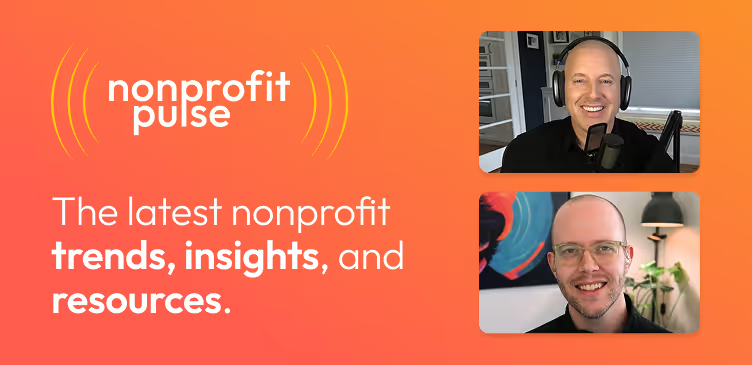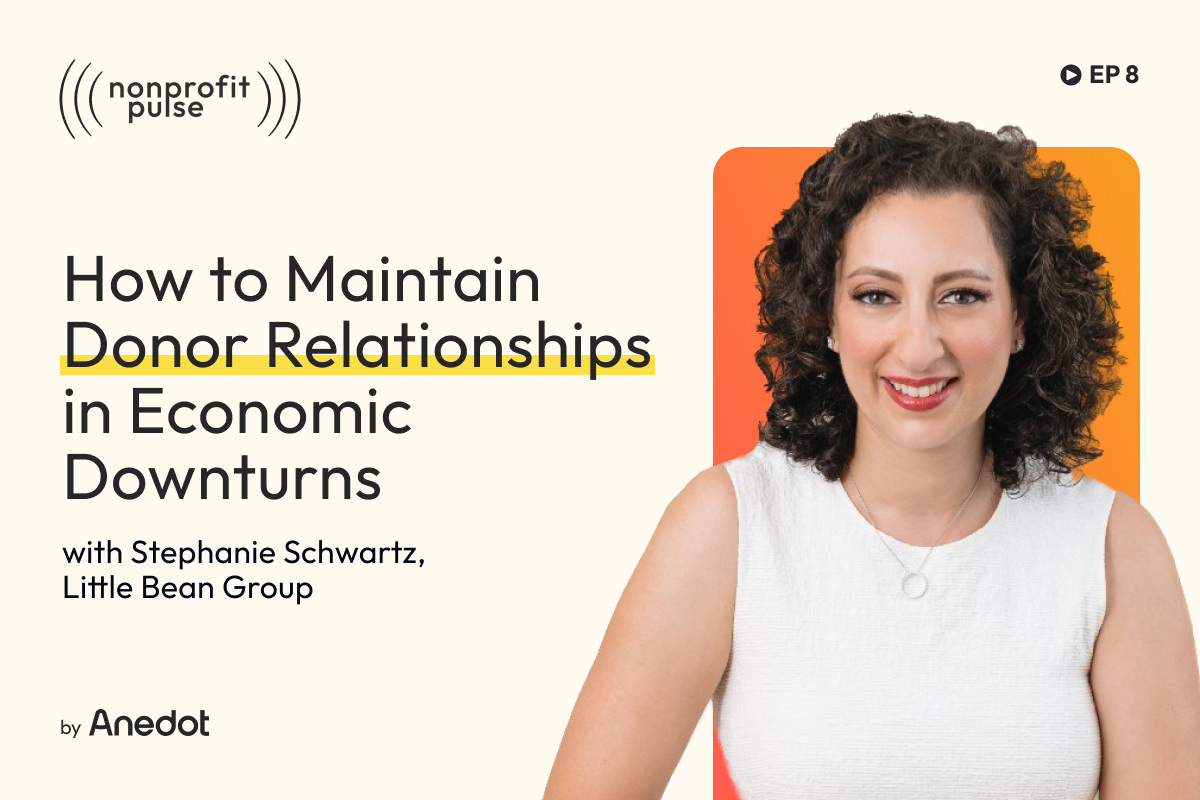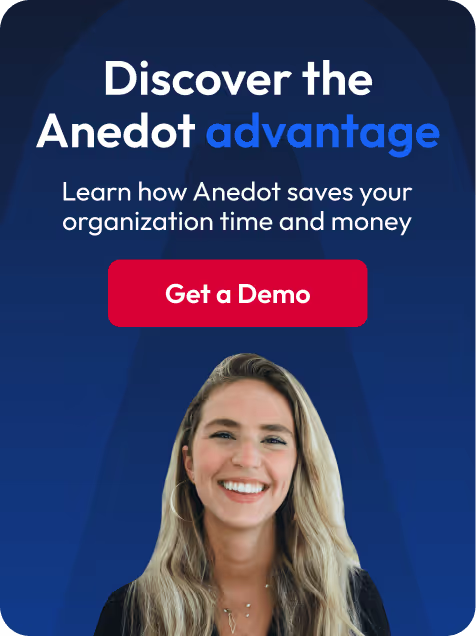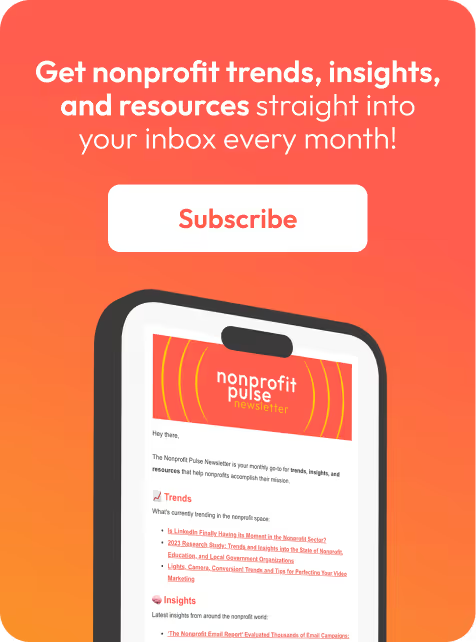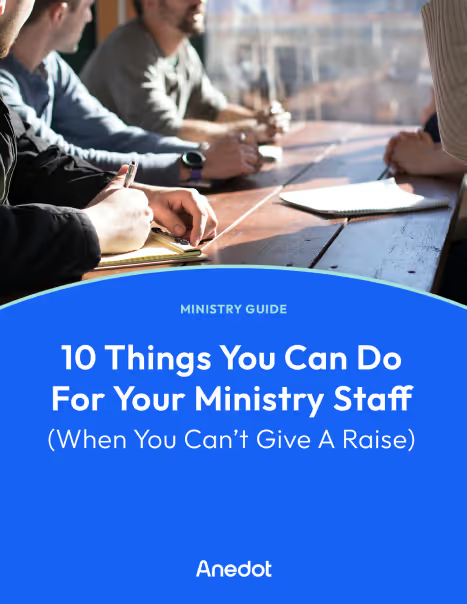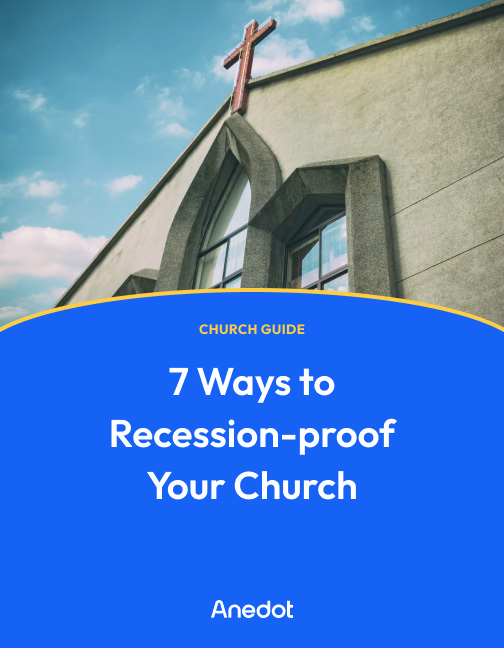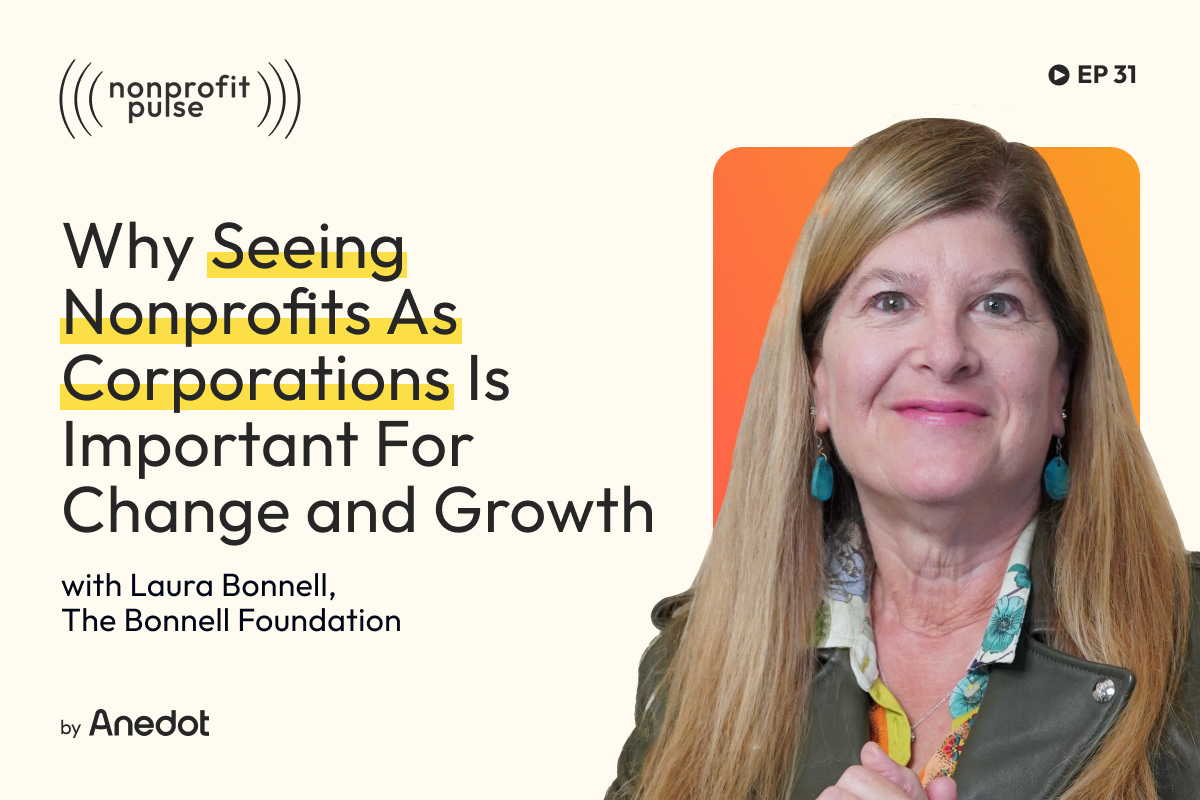Podcast episode transcript ↓
Josh:
Maintaining and developing donor relationships is fundamental to your nonprofit’s success.
But during economic downturns or financial hard times, this can be a unique challenge for nonprofit leaders.
So, what can your organization do to lean into relationships during these seasons?
I’m Josh with Anedot, and welcome to Nonprofit Pulse where we explore trends, insights, and resources that help nonprofits accomplish their mission.
On this episode we are joined by Stephanie Schwartz on the topic of maintaining and developing donor relationships and how nonprofit leaders can continue to build authentic relationships through financial hard times.
For almost 20 years, Stephanie has worked inside and outside of nonprofits, bringing expertise in leadership, fundraising, and major gifts.
She is the CEO of Little Bean Group, providing fundraising strategy, support, learning and development, and thought leadership to nonprofits and institutions.
Hey, Stephanie, thanks for coming on Nonprofit Pulse.
Stephanie:
Thanks, Josh, great to be with you.
Challenges donors and nonprofits face during economic downturns

Josh:
Yeah, so today we are talking about maintaining donor and supporter relationships during economic hard times or downturns.
And, you know, I've said this previously on the podcast, it's kind of a question, are we in a recession or are we going to go into a recession? No one really knows.
The latest comments from the Federal Reserve seem to indicate that we may avoid a recession.
But either way, times are difficult for many right now, and I believe many nonprofits are starting to see a dip in donations and gifts.
So, you know, first, let's just talk about economic downturns and how this impacts both donors and organizations.
You know, first donor side, right? What are some unique challenges that donors are going to face during an economic downturn?
Stephanie:
Sure. And let me be clear. I'm not an economist or a banker, so I have no insights necessarily into the economy.
And I say that because I think for donors, there is a perception now, whether it's reality or it's just how they feel that the economy is struggling.
And even though we see that unemployment rates are low and that there are other strong economic indicators, people feel insecure when the market is volatile, people feel insecure with certainly nobody likes interest rate hikes.
That doesn't make anybody feel good. And I think it's important to recognize that that's how donors feel. So whether or not that's the reality, that's how donors feel.
And I think it's important, you know, just for people who work in organizations to put ourselves, think about ourselves. We may also feel insecure even if our jobs are secure and our families are okay.
So it's important to, I think, take a step back and have that perspective at the very high level of the gift table for people who are very, very philanthropic and very wealthy.
There are possibly some challenges in terms of how people are thinking about making gifts.
So are they making gifts from their wealth or from their income?
Depends for people who are making gifts from from DAFs, donor advice funds, or other charitable giving vehicles.
They are probably doing okay, but they still may feel insecure, whereas donors who give smaller gifts or people who give directly from their income may also feel insecure given the economic situation and may have actually had hits to their income, which would obviously impact their personal giving.
Josh:
Yeah. So let's talk about the organization side.
So what are some of the challenges that an economic downturns that nonprofits face?
You know of course with the revenue side but even beyond that, you know supporters, volunteer recruitment, those things.
What are some of those challenges for nonprofits?
Stephanie:
I think in times of insecurity, people tend to turn inward.
It’s the natural I think defense mechanism and so I've heard this for many of my clients that things are sort of down and slow overall.
So staff morale is down. Staff burnout is high. Donor, you know, the donor situation we've touched on, donations are at best flat.
And even for organizations that are doing okay financially the donation increases are lower or less than they have been in the past.
And I've also heard that volunteer numbers are down as well.
So organizations feel when times are hard, that I think employees turn inward and external stakeholders turn inward as well.
And I think generally there's less enthusiasm and collaboration for the work that the organizations are doing.
Josh:
Yeah, I would think the time resource for both donors and organization staff would be impacted too, right?
Like we know several families and friends and people connected with us who were single income and now because of inflation and prices and like you mentioned, insecurity, they've gone to the other spouse going back into the workforce and that takes away time for volunteers as well as for organization staff who may be picking up a second job, a second part time job, or entering the gig economy with Uber, Lyft, DoorDash.
I would imagine that would also play into just the overall health of both the donor supporter and the organization.
Stephanie:
Absolutely. I mean, that's a direct, that's a direct impact of an economic slowdown or recession.
And we were chatting, Josh, before we started recording about the heat. Right. Much of the United States is extremely hot.
I mean, I just sense that they’re generally like lethargic time now, even though there are people out there, just as you said, trying to pick up extra work and trying to to make things work for them and their families, that certainly impacts giving, volunteering.
I think overall morale. Yeah, it's a sort of a strange time and also not an easy time for individuals and certainly for nonprofits as well.
Why nonprofits should lean into donor relationships during economic downturns

Josh:
Yeah. So in this episode we want to talk about addressing those issues.
So addressing limited resources, insecurity around income, and how can nonprofits really lean into maintaining relationships with donors, with their donors and their supporters.
So what are some tips that you've seen working around your clients, around the nonprofit space, things that you would encourage nonprofits to do?
Stephanie:
Sure. It's a great question, and I will frame it as follows. I think there are things to do.
So I want to talk about what to do. But then I also want to talk about how to do it, because I think those are two unique perspectives, but are both important.
So when we think about donors overall, so my background is and my work is mostly focused on major gift fundraising.
So I think I'll start from that vantage point first, which is -
I think really the most important thing organizations can do right now, be their supporters and donors, is to communicate with them, build relationships with them, and steward them.
So communicate what you're doing, what the impact is. You can, I don't, I've seen some organizations sharing, you know, big summary emails of, you know, all they have accomplished in the last year.
And I would lean toward a leaner and I think more personalized approach, taking the opportunity throughout the course of the month on multiple occasions to share stories of impact, to share, you know, small updates in a way that can connect with people more individually and personally.
→ Learn more about nonprofit storytelling!
For donors, I would spend the dog days of August just on the phone, just picking up the phone and calling donors with no other agenda than to say, thank you so much for your ongoing support.
I'd love to hear a little bit about how you're doing. I mean, really just expressing gratitude and thanking donors and using those phone conversations as an opportunity to build relationships.
Just hearing how people are doing. Asking them if you don't already know, how do they first get involved with you? Why is the cause and the issue important to them?
What else do they support in the community? Having conversations, getting to know people, building relationships is so, so, so important and impacts obviously what donors may give this year.
But putting that aside, it's even more important in the long term in terms of securing future donations.
I’d also encourage organizations to think about are there ways in which you can bring in other streams of revenue?
Usually when we talk about fundraising and my work focusing on mostly on individual giving, we're always talking about gifts from individuals and cultivating large donors for larger initiatives.
But are there some things you could try in the short term to bring in different types of revenue? Is there an event where you could sell tickets that might offset the cost of the event?
Can you try some small, some smaller specific fundraising drives and initiatives to cover certain things that your organizations are doing?
I serve on the board of a local nonprofit in the DC area, the Greater DC Diaper Bank, and I saw they just did a mini campaign for wipes, for baby wipes. There's a big need.
And they sent out a really nice, targeted campaign to their supporters and linked specifically to the Amazon store where you could purchase the wipes and have them be sent directly to the bank.
And and I can see on the back end how successful it's been. And so every wipe that's purchased and donated is one last one that the organization has to purchase in order to be able to share it with those in need.
Organizations, I think can be very creative in terms of thinking about short term and longer term revenue diversification.
Tips to foster supporter and donor relationships

Josh:
I love that. Yeah. So, outreach, exploring new programs and services.
And you know, just on the outreach side, I love how that would differentiate your nonprofit from potentially some others in that you would be calling your donors with no agenda, just saying, hi, thank you for supporting us.
We want to know who you are. We want you to know who we are.
You know, the fact is, most nonprofits are not going to do that. Whether that's a decision as far as time resources or they don't simply have the staff to do it, or they’re not comfortable.
I think that's a huge opportunity to differentiate your nonprofit from others with that personal outreach and then the new programs and services. So helpful.
And there's so many needs that nonprofits know exist but just haven't been able to spin up a program or a service to help with those.
And you know, I saw a nonprofit of Anedot recently sending out a survey asking what are some of the priorities you would like to see in our nonprofit in the next year?
And I thought that was just brilliant to really get buy in from your donor base, from your supporter base, on what kind of impact they would like to see when it comes to your mid-year report, your end of year report, so that you're really matching that impact with those dollars that, as we mentioned, are maybe getting more scarce as the economy kind of goes through its cycle.
Stephanie:
I love that survey idea. I actually have not heard of that.
And I, I love that. I'm reminded that last week I got an email from an organization that I have supported over the years, but I guess it had been a little while and they sent me a personal email and said, Stephanie, we're reaching out to people who have supported us in the past but we haven't talked to recently.
We would just love to hear about how your experience was with us. It’s a refugee resettlement organization.
So there's a lot of hands on work. And I thought, oh, you know, there's nothing in there about fundraising.
And I sent them an email back and he sent me some other information about some of the ongoing needs in the community.
And it was nice to feel like somebody solicited my advice.
I could respond in a you know, it just took a couple of minutes, but I had a really positive interaction with the organization and it put it back on.
It put itself back on my radar with what required probably pretty low effort from the organization’s end.
I think sometimes in fundraising, because it is so metrics driven and data driven, everything we must do, it must lead to something else and there must be a measurable result. And I think this is the time to put that philosophy a bit to the side. The only measurable result you need from reaching out to people is just time on the phone with them or emails with them. It's just communication. There's really nothing else that needs to be measured or tracked. You just need to get on the phone with people and talk to them.
Josh:
Yeah. What are some thinking about the supporter side of this equation, what are some ideas that nonprofits can lean into?
Their volunteers, those who may serve in different chapters or even have a board presence in different chapters.
What are some ideas for nonprofits to lean into the supporter relationship during these hard times?
Stephanie:
It's a good question.
I think, for board members and other long term stakeholders and supporters who are really familiar with the organization, they can be people who can make calls to donors to say thank you and just to chat with them.
I think board members reaching out on behalf of the organization and almost playing that staff role, but talking, you know, from supporter to supporter is really effective and impactful.
And I think it's really nice for the board members and volunteers to have that role.
I would think about in the next couple of months some kind of volunteer appreciation activity.
It doesn't need to be an event that takes up a lot of time, maybe a conference call with the CEO or executive director or a Zoom.
Just some time that's devoted to people who have given up their time in the past, who are often not stewarded in the ways that donors are just to have the opportunity to have some face time with organizational leadership or people who are served by the organization.
I think you can, in essence, treat them the same way as you treat donors, spending time with them, learning their stories and just understanding why they're motivated to give of their time or other resources.
Josh:
Yeah. Thinking through some opportunities with donors during economic downturns, is there an opportunity there to as nonprofits build relationships with these donors?
Is there an opportunity to say hey we know your giving may have decreased or you've had a pause in giving, but we would love to invite you to just serve with your time and really onboard them into the supporter volunteer side of the nonprofit.
Would that be appropriate or helpful?
Stephanie:
I think absolutely. I mentioned at the beginning of our conversation that I wanted to talk about what to do and also how to do it.
And in terms of how, that's absolutely something that has been top of mind for me, asking people, is there a way you can be and stay connected that you're comfortable with?
And to a donor, that might mean making a gift that they are comfortable with that might have been less than they've given in the past. It might be serving as a volunteer.
It might mean coming to a program. I think when you take giving out of it, it really forces organizations to think about, okay, how do we actually connect our supporters and our donors and our stakeholders to our work?
And that you need to think of things that don't just involve money.
So, yes, I think that's definitely an opportunity.
And certainly volunteering is really top of the list in terms of how people can help.
Josh:
Yeah, I know at Anedot we've seen success in our customers with an upsell asking, hey, you know, you want to give $50 today, but would you give $10 per month instead?
And donors, actually most donors will do that. You just have to ask them for it and have the technology to ask them for it.
But, you know, there you're looking at $120 of revenue versus the one time $50 gift.
And I think it brings them kind of deeper into a commitment to the organization to where then you can have that conversation about, you know, we know you're a donor, but we'd love to have you as a volunteer or a supporter or even a potential board seat. You know, if you have a need for that.
Stephanie:
For sure. And I completely agree with you and Anedot’s thinking there, there's so much data to back that up.
And I think it goes without saying that, so someone then becomes a $10 monthly donor.
They surpassed the 50 and then the retention rate year over year with monthly donors is quite high.
I think converting lower dollar, you know, one time annual donors to monthly donors is a really nice way to make giving feel more accessible to people and also offer organizations the opportunity to better steward people and bring them into the fold because they're there with you every month.
So anything that goes out, they receive.
I just was looking at an organization today that I was thinking of supporting and I noticed on their website there was a there were various giving levels and it had the monthly what the monthly donation is that adds up annually to that level. And I thought, oh, I haven't actually seen that in a while.
Usually you see, you know, there's a prompt, you know, asking you to give an amount and then, or do you want to participate in a recurring giving program?
But this was looking at the whole gift and breaking it down monthly, right in front of you. And I thought that was well done.
The importance of empathy and kindness when talking to donors

Josh:
Yeah. So let's talk about anything else on the how side of how to do these things that you'd like to share.
Stephanie:
Yes. So when you are talking to people, donors, foundations, stakeholders, volunteers, anybody, you have to be kind and empathetic, right?
We don't necessarily know - people's situations from the outside may look fine and we may not understand why they've decided to skip a year in giving or decrease the gift, but we have no idea what's going on behind the scenes and we need to be kind and understanding and proceed with care and empathy.
Now, that's not to say we back off and we don't ask people to support us, but we have to be kind and empathetic and know that there are people who are struggling or people who have had significant things, you know, expensive things pop up in the last year and we may not know about it.
I think we also need to make sure that we're continuing the conversation with people.
So if someone says, no, I can't give this year or, you know, usually I get 10,000, but I'm only going be able to do 5,000 this year that we take the time to thank them for everything that they have done previously.
All the time they have given, the support they've given, the donations they've made, that we make sure we take the time to appropriately thank them.
I think you can never - you need to thank people genuinely, but if you are genuine in your approach, you can never thank people too often.
And I often see organizations are so quick to sort of adopt the sales approach and try to, you know, get that person back in the sales pipeline and negotiate. And I don't - that may produce a short term result.
They don't want to discount that, but I don't think it suits organizations while in the long term and it makes people feel pressured and just generally sort of icky and turned off.
I do think it's okay to say, you know, if I'm soliciting you, Josh, and you're sharing with me that you're going to need to likely lower your support this year, I think it's completely appropriate to say:
Josh, thank you so much. We would be grateful for anything that works for you this year. Is there an amount that you're comfortable with?
We can ask and try to move and move the ball forward. That's our job.
But we need to do so with kindness and empathy and treat people like people.
And going back to earlier parts of our conversation, also make sure to offer ways that people can stay connected if they're looking to take a step back through continuing to attend fundraising events, staying on mailing lists, perhaps volunteering, like just because someone says no now, it's not no forever.
And I have seen - I was out, I was a big time front-line fundraiser in 2008 when really everything crashed. And I remember working with people who said like, I definitely cannot give this year.
It's just not going to happen. And I really pushed people to say, that's okay, you know, we're here for you. We don't want you to completely disappear and leave, you know, leave the fold.
And we really made a big effort to stay in touch with people and maintain those relationships.
And I have seen people who gave, you know, couple thousand dollars or $10,000 back at that time who are now, you know, significant six figure donors.
We need to make sure that just because somebody says "no" now that we don't let them go away, because they will likely give more in the future, especially if you stick with them.
Josh:
I love that. I love that.
And, you know, just a few thoughts.
When nonprofits see donations, whether it's a monthly donation be canceled or they get an email or a phone call about reducing their gift, sometimes it can feel as though it's really a transactional and oh, no, you know, we've lost this donor, not understanding the donor’s perspective, that they are truly sad and impacted by the fact that they can't give especially a long term, long term donor.
As you mentioned, just having that empathy and kindness in approaching that situation, because it really bothers a lot of donors when they can't meet their commitments to a nonprofit they love.
And also too, I love about keeping in contact with donors who may not be giving any longer and just shows what a relationship truly is with these donors as individuals, as people.
And it shows that it's not transactional, that, oh, you no longer give so we're going to remove you off our list. I love that.
Keeping people on the list, keep engaging with them and possibly even segmenting that out into a, you know, future volunteer list as well, knowing that they can't give right now of their financial resources, but maybe they do or they can give of their time.
So I think that's just a great opportunity.
Keep leaning into those to the outreach, to the communication, showing that you care about them and that this was not a transactional relationship, but you really value them and their support.
Stephanie:
Yeah, and just to put a finer point on that, because I talk about this topic a lot and I think sometimes those of us who do this a lot tend to sort of gloss over the details.
By staying contact, I mean, specifically, leave people on your email lists, leave them on event lists.
If you know their birthday or another significant date in their life, maybe it's noted in their record or it's you have it in your calendar every year as a recurring event.
Send them a quick birthday greeting, send them a birthday card. Make sure you send people a holiday card.
I think looking at people whose gifts have either decreased or have dropped in the last year is a wonderful segment of people to target for cards and calls around the holidays.
I think if you are a donor who has not been able to give in the last year and is feeling a bit down about that or depending whatever is going on in your life, how nice to get a call from someone just wishing you happy holidays.
Happy New Year with no other agenda and just saying, oh, Josh, I was thinking about you. I haven't heard from you in a while.
I hope you and your family are well. I’m wishing you all the best in the new year. What a nice, nice thing to receive as a donor. So don't think it means.
Josh:
Yes, absolutely.
Stephanie:
Yeah. It doesn't need to be a lot it doesn't need to be, you know, a whole big campaign, just meaningful touches that engage people and let them know that you're thinking about them.
Josh:
Yes. And just a final thought on the lapsed donor or the donor who has to scale back their giving, you know, a donor could be giving 10,000 a year for ten years.
And they recently have to scale back to 5,000 per year. And really thinking through an empathetic lens there, that 5,000 they're giving may be harder to give right now than all of the 10,000 each year they did previously.
And so thinking through that lens of being able to bring kindness and empathy to those communications and that relationship, it really does impact donors when they have to either stop giving or reduce their giving.
Stephanie:
Yes, I think that is such a salient point for me.
I was just working with a client and we were talking about some older donors who had some changes to their financial situations and have had multiple grandchildren be born and they're reallocating some of their financial resources.
And someone made that same point. You know, this gift that they're giving this year is lower, but it is harder for them and it is more meaningful that they have stepped up to give it this year because it's not as easy as they used to be.
And I think that's such an important point to keep in mind. I'm so glad that you raised it.
Closing thoughts

Josh:
Yeah. So, Stephanie, imagine you're standing on stage in front of a thousand nonprofit leaders and you can give one word of encouragement, one sentence of encouragement to the audience around maintaining donor and supporter relationships during economic hard times.
What would you say?
Stephanie:
Great question.
I would say take the time to build and maintain genuine relationships with all of your donors and supporters.
Josh:
Love it. Love it. Any resources out there, Stephanie, that you would recommend to our audience?
Stephanie:
Sure. I write a monthly newsletter that's full of information on this topic and others that people can always subscribe to my newsletter.
I also find it really beneficial to follow different organizations online on LinkedIn or sign up for their newsletters.
It's really interesting to receive, to just look at how other organizations communicate and to think about from your perspective, like receiving the information.
How does it sit with you and how does it land with you? I always encourage my clients to sign up for the newsletters and updates from other organizations in their general area or in their space.
Josh:
Awesome. Yeah. And you can find out the links that Stephanie mentioned in the show notes of this episode over at Nonprofitpulse.com.
Stephanie, thanks so much for coming on and love this conversation and I hope it’s helpful to our audience.
Thanks for bringing all of your expertise and ideas and we'd love to have you on again in the future to talk about major gifts.
Stephanie:
I love that. Thank you so much, Josh, It's been a really wonderful conversation.
Josh:
Hey, thanks for checking out this episode!
If you enjoyed it, please share it with others or leave us a rating and review.
To find show notes and resources mentioned in this episode, visit Nonprofitpulse.com.
There, you can also sign up for the Nonprofit Pulse monthly newsletter where we send the latest trends, insights, and resources to help nonprofits accomplish their mission.
We'll see you next time.
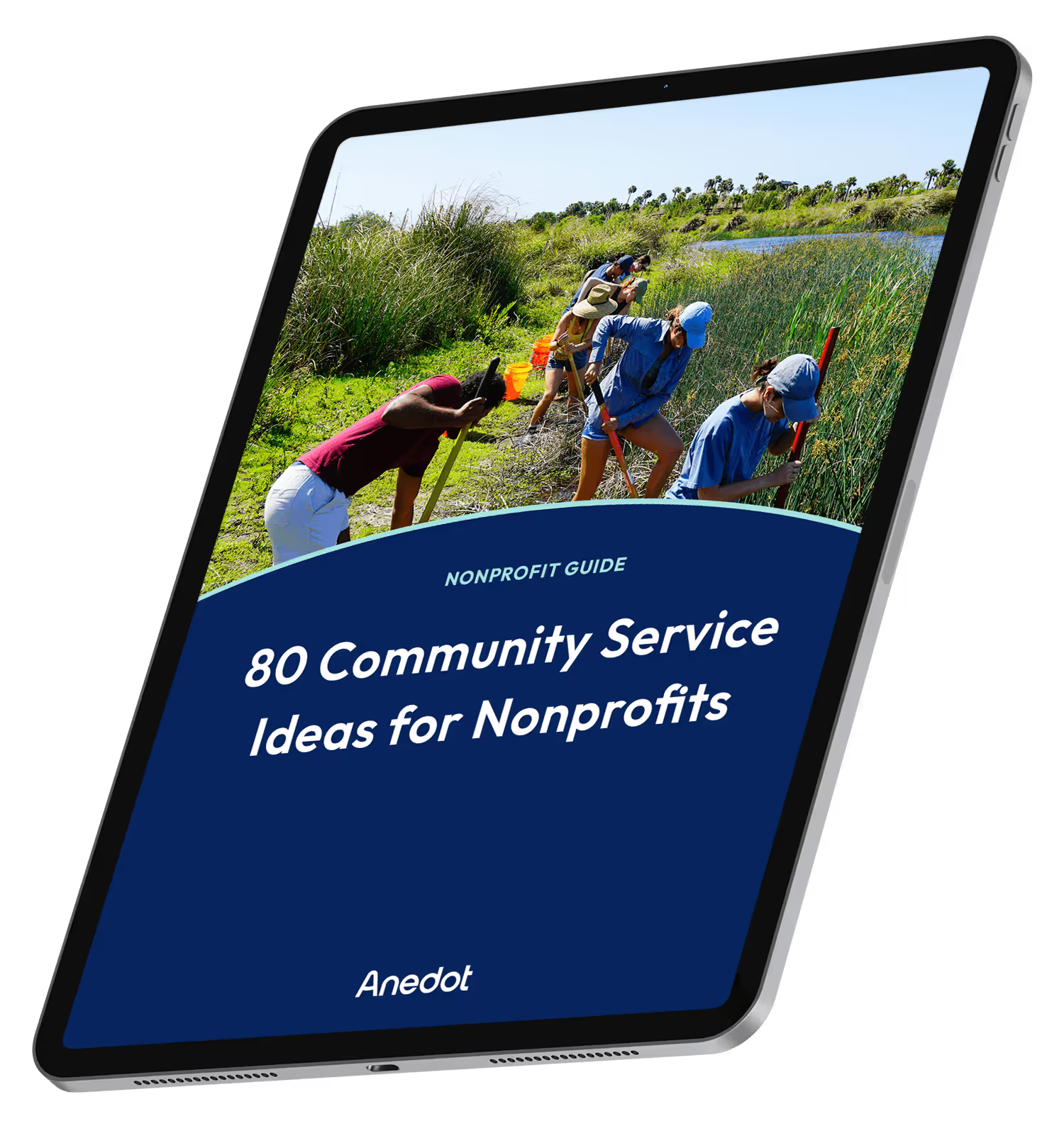
80 Community Service Ideas for Nonprofits

